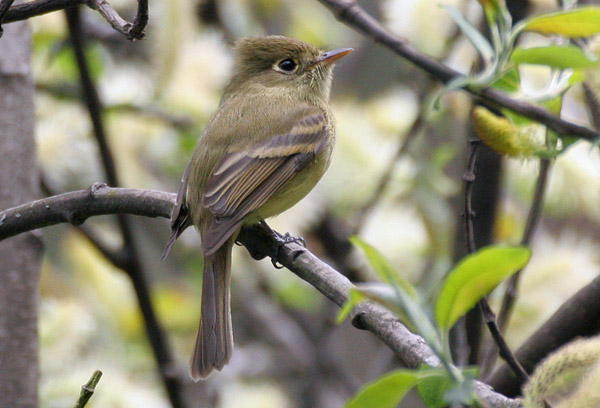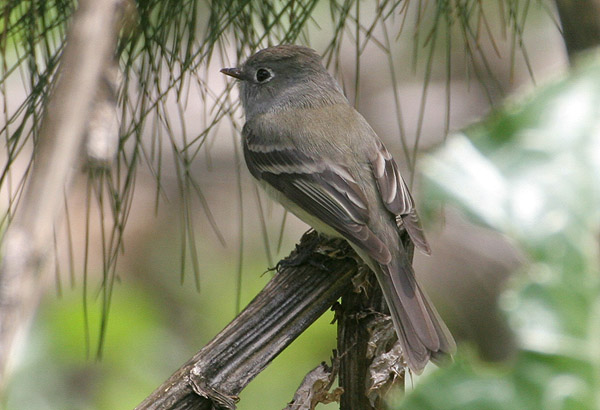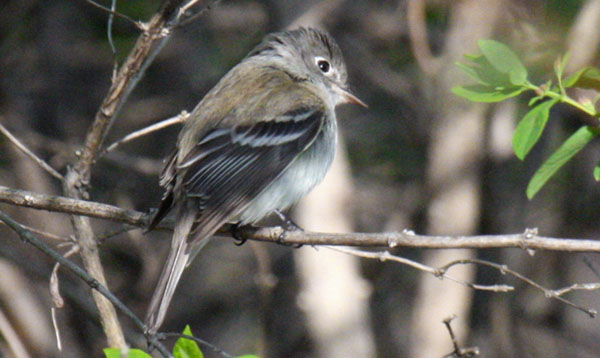Some types of birds, such as raptors, waterfowl, and warblers, appeal to both birdwatchers and sane people alike. Members of these avian families are fun to observe at least in part because they appear in a broad array of easily-discernible forms. Given a minute with a field guide, most individuals can separate different types of ducks or owls. But other cognate bird species are so alike in appearance that even experienced birders have trouble identifying them with confidence. For example, many birders find themselves frustrated by gulls, since they all look so much alike yet dissimilar. I also take little pleasure from picking out the individual species in a flock of peeps. But the toughest group of North American birds to identify in the field has to be the assorted Empidonax flycatchers.

Cordilleran Flycatcher by Charlie Moores
All tyrant flycatchers in the genus Empidonax, called empids out of either affection or frustration, are suboscine songbirds with olive upperparts, pale throats and bellies, and whitish wing-bars and eye-rings. These active insectivores are usually pretty small, roughly 5.5 inches in length, give or take a half-inch. In size and plumage, which is generally variable due to due to molt, wear, and age, the various Empidonax species are virtually identical. Thus, to identify an empid confidently without resorting to an autopsy, one must rely on voice, behavior, habitat, or range. The bad news is that habitat and range often overlaps for multiple species, especially during migration. Even worse, empids have an uncanny knack for keeping their mouths shut just when it comes time to make an ID. In the absence of song or call, even many expert birders give up on classifying these elusive look-alikes.
Five species of Empidonax flycatchers are associated with eastern North America. The Least Flycatcher (E. minimus) is, as its name suggests, the smallest of the eastern group, although differences in size are often too subtle to be diagnostic. The Alder Flycatcher (E. alnorum) and the Willow Flycatcher (E. traillii) were considered to be one species, the Traill’s Flycatcher, until just 1973. The two, however, have distinct voices and nest types. The Acadian Flycatcher (E. virescens) may not be cajun, but it is a bird of the bayou, usually found at water’s edge. The Yellow-bellied Flycatcher (E. flaviventris) has the most colorful belly of the eastern group, but don’t be mislead; an empid with a yellow belly is not necessarily a yellow-belly. See how baffling this can be?

Pacific-slope Flycatcher by Charlie Moores
Least, alder, willow, and even acadian flycatchers can be found in the western regions of the continent. The latter two are not the only recently split siblings in those parts. The Pacific-slope Flycatcher (E. difficilis) and Cordilleran Flycatcher (E. occidentalis) are known collectively as the Western Complex. These birds are distinct from other empids due to their brighter green and yellow coloration, but they are tough to tell from one another. The Gray Flycatcher (E. wrightii), more gray than most, is well-known as a hearty tail pumper. The Dusky Flycatcher (E. oberholseri) may be considered easier to identify by voice than its peers because it is one of the noisiest empids. Hammond’s Flycatcher (E. hammondii) looks a lot like the Dusky, but has longer wings and a shorter, darker bill.

Least Flycatcher by Charlie Moores
One final North American empid, the Buff-bellied Flycatcher (E. fulvifrons), is easily the least maddening of this genus. Not only is this Mexican species the smallest of all North American Empidonax flycatchers, its rich orange-buff breast distinguishes it clearly from its cousins.
The American Birding Association offers a fantastic online photo quiz that highlights the futility of trying to identify an empid accurately without something like fifty years of experience. My recommendation is to not waste too much time with the photo, but instead to marvel at the explanation of the insanely painstaking detail involved in putting a name to that adorable whiskered face.













But what about the Central American species? You should mention them, too. Birders should know to keep an eye out for vagrant empids 🙂
Nick, that’s a whole other layer of complexity. If I factor those species in, I may never be able to ID an empid again!
Haha… then don’t go to the neotropics in the winter, when our species are migrant possibilities alongside the natives.
I think Empidonox is another word for frustration! LOL
Tell me about it, Nick. Just having to contend with both eastern and western US species in Guatemala threw me off my game. That’s why I try to surround myself with talented birders. Speaking of which, when are we hitting Montezuma…
Mon@rch, I couldn’t agree with you more!
I’m booked the next two weekends, but that’s good because it will allow the southbound shorebirds to start rolling in. So, late July or early August 🙂
(Southbound migrants? But its barely summer! Ahhh!)
Does the Pacific Slope flycatcher always have that distinctive eye ring? I am a new birder in Southern California and the family of flycatchers living on my balcony are really frustrating me in terms of identification. They look just like the Pacific Slope in your picture (yellowish breast and belly) but the eye ring isn’t so distinctive. I’ve got lots of pics and video and I know the call well. Could you help me ID them?
Absolutely, Jon. Send your pics to me (mike AT 10000birds DOT com).
Here are some pics:
http://skitch.com/jonsnetwork/xm2p/flycatcher2
http://skitch.com/jonsnetwork/xm2m/flycatcher1
http://skitch.com/jonsnetwork/xm2e/blackphoebeandfriend
Any help is appreciated. Thanks!
Jon, the birds in your pics look more like phoebes than empids to me. How does Say’s Phoebe look?
That’s funny, because just today I got my copy of Sibley in the mail and I flipped straight to the flycatchers. The call matches identically to the “low, plaintive, clear whistle pdeeer or tueee”, but the pictures in the book have a distinct orange belly – not yellow. Your pics make it obvious that my birds are Say’s Phoebe’s though. I hope the the rest of the colors in my Sibley edition are accurate. Thanks for your help.
Sibley is right about the orange belly but some of these birds are more colorful than others.
And so we come full circle… it was this blog’s post on how to host a carnival that allowed me to create COTEB in the first place!
Thank you for the excellent how-to, and welcome aboard!
Thanks, Dana, I appreciate that. I’m also looking forward to sharing more of the elite bastard part of my personality through your superb carnival!
Hi – Just an observation but that middle flycatcher looks like a Hammond’s to me. It has very long wings, and a contrasting greyish head and greenish back. A Pacific-slope would be greenish all up the head and back. I guess this underscores the issues of why they are so troubling to people. It is a lot of nitpicky stuff to look at, and also a lot of experience needed as the books and other reference materials generally do not do them justice. Cheers, Al.
I am in Pleasanton Texas. I’m not a bird watcher, just like to look up into the sky to see what I can see. Anyway the San Antonio express newspaper had an article about a Pine Flycatcher down at Choke. Canyon State Park. I could swear I saw this bird where I live. In,I think, the bird watchers came to HWy. 37 at Pleasanton to see the LADDERBACK WOOD PECKER. I had been watching this bird in nieghbors tree for at least 2 weeks. I looked the bird up on the internet to ID it. In this same yard were serveral different birds. My Humming bird feeder brought a family of humming bird i had not seen, had a red ring around their necks only could be seen when flying away. Pleasanton, Texas seems tobe a bird stoppings off place. ther is so much to see in nature.
Hi! I have a yellow bellied flycatcher that keeps packing at all my windows. he doesn’t seem scared when I get get close to the window. I think he really wants in my house! Are these specific type of birds okay for house living? Do they only eat flys and insects?
Agree with Alvaro, the second photograph is a Hammond’s Flycatcher, the long “butter knife” primary projection is typical as well as the mixed gray and olive plumage aspect.